Hudson River Almanac 6/23/18 - 6/29/18
The New York State Department of Environmental Conservation sent this bulletin on 07/06/2018 02:00 PM EDT |
| DEC Delivers - Information to keep you connected and informed from the NYS Department of Environmental Conservation |
| Share or view as a web page || Update preferences or unsubscribe |
|
|
OVERVIEW The spawning season for Atlantic sturgeon, the largest creature that swims in the Hudson River, was nearing an end. At the same time, our first monarch butterfly caterpillar hatched from its egg. It was also a week of snakes, moose, and fledgling bald eagles. HIGHLIGHT OF THE WEEK
[How old was this sturgeon? After reading the literature for age-at-length for Atlantic sturgeon, it became apparent that this question delves into a realm of unknowns. Doing a little math, the literature suggests that an 8.5-footer may be 45 years old. If we take the growth curve to be 1:1, which it likely is not, the 14.1-footer might be 75 years old. Perhaps a reasonable estimate? Tom Lake] NATURAL HISTORY ENTRIES 6/23 – Pine Bush, HRM 81: I found my first day-old monarch caterpillar today on a foot-tall milkweed plant. I had looked at many plants for several days finding nothing and then there she was. It was a welcome sign that at least some things on earth are alright. Monarchs will continue to thrive in tropical areas but the unique North Eastern migrating population is threatened by habitat loss, drought, pesticides, and human apathy. [Monarch butterflies (Danaus plexippus) move through a complex metamorphosis from egg to adult. An abbreviated description of the process begins when their eggs hatch after 3-6 days resulting in their larvae (caterpillar) form. For the next 10-14 days, they feed exclusively on the leaves of milkweed shedding their skin several times as they grow. They next create a chrysalis, or pupa, where they will remain for another 10-14 days. An hour after emerging from the chrysalis, the transformation to an adult butterfly is compete. They will flex their wings for a few hours before taking flight but may take a full day before they fly. In another 4-7 days they will be ready to mate. Unfortunately, monarchs will also lay their eggs on leaves of the invasive black swallow-wort (Cynanchum louiseae). The plant, however, is poisonous to the monarch’s larvae. Betty Boomer, Tom Lake]
6/23 – Westchester County, HRM 30: I was jogging with my dog in early evening at Rockefeller State Park Preserve when we came upon a copperhead on the trail. It was swallowing a rodent – the tail was still protruding from its mouth. We waited patiently until the snake moved away. (Photo of copperhead courtesy of Joe Walston)
6/23 – Yonkers, HRM 18: We held our River Explorers Program today at the Sarah Lawrence Center for the Urban River at Beczak. Seven students and their parents, many first-timers, helped us seine the river and the low tide gave us great promise. They were excited that their data would be used by DEC, and elated to be scientists for a day. High count in our seine was 51 young-of-the-year (YOY) Atlantic menhaden, a marine herring. Invertebrates included moon jellyfish, shore shrimp, and comb jellies. 6/24 –Rhinebeck, HRM 90: It was a just a brief sighting, but I'm pretty sure there was a summer tanager in the maple tree beyond my deck this morning. Maybe there will be other reports from birders in the area. [The summer tanager (Piranga rubran), an uncommon visitor to our area, is related to cardinals and grosbeaks. This southern bird whose presence is listed as “casual,” has had several reported occurrences in Dutchess County including 1962 (Cruger Island), 1988 (Dover Plains), and 2008 (Salt Point). Ralph T. Waterman Bird Club] 6/24 – Bedford, HRM 35: It was a warm afternoon at the great blue heron rookery. There was a lot of panting going on but not much activity. The nestlings continued to grow and look more like their parents. They all appeared to be well fed. The adult herons are reported to have very good vision and also hunt for food at night. 6/25 – Dutchess County, HRM 84: Against a robust northwest wind that was embracing a strong flood tide current – wind against tide – DEC Region Three Fisheries struggled to set three 300-foot-long gill nets over bottom sediments of coarse sands, gravels, and small boulders favorable to spawning Atlantic sturgeon. The nets ranged in mesh-size from 11-14 inches (mesh size selectively catches certain size fish; these three were targeting large sturgeon). We let them soak for 30-45 minutes. Our catch included nine adult Atlantic sturgeon, almost all of which were probably males. Four of them were quickly scanned for passive integrated transponder (PIT) tags and released. The other five were measured, PIT tagged, and released. They ranged in size from 5.3 to 6.2 feet long. One of the nine sturgeon had been previously caught and released. The water temperature throughout the water column was 73.2 degrees Fahrenheit (F). [Small PIT tags, also called radio-frequency identification tags (RFID), are surgically implanted in the fish’s abdomen in a mildly invasive procedure. Through a transponder and a reader (receiver), they use electromagnetic fields to automatically identify and track tags attached to the fish. Tom Lake]
6/25 – Yonkers, HRM 18: We began conducting training for our summer program at the Sarah Lawrence Center for the Urban River at Beczak. Seining at high tide, our catch was meager with only moon jellyfish and white perch. This was unlike an earlier haul when we got into a school of YOY herring. For a while, our dichotomous key led us astray until we realized we had captured a large number of Atlantic menhaden that measured 50-75 millimeters (mm). 6/25 – Delaware River: A severe storm on May 15, that included tornadoes, destroyed bald eagle nest NY459A in the Town of Wappinger. A pair of 42-day-old nestlings that had fallen 75 feet to the forest floor were rescued and taken to the Delaware Valley Raptor Center in Milford, Pennsylvania. One nestling was in good condition but the other had a broken leg. [Update: The uninjured eagle was released today along a shallow section of the Delaware River near an eel weir that also traps American shad. There was an abundance of fish carcasses around that the eagle could feed off until it honed its hunting skills. We saw plenty of other bald eagles there, both adults and immatures, and the bird flew strongly as we knew it would. The injured-leg eagle was not faring as well as we would like. Surgery went well and the leg had healed well with full use and extension. The problem was with the other un-fractured leg. For some reason it has been weak. We do physical therapy every day with him and haven't yet given up. The decision will come down to quality of life. Rest assured, nobody loves these birds more than we do. We will make the right decision for him if and when the time comes. Delaware Valley Raptor Center] 6/26 – Town of Wappinger, HRM 67: The severe storm on May 15 that destroyed bald eagle nest NY459A did not deter the adult pair from starting a rebuilding process. Both adults have been at the nest site on almost a daily basis. This bodes well for 2019 nesting prospects. We often speak of the resiliency of bald eagles and this was one more example. 6/26 – Beacon, HRM 61: Today was a study in the value of patience. I got my lines in the water at Long Dock Park at noon but had to wait three hours before the fish showed up. Eventually I caught and released three carp, three channel catfish, a goldfish, and a brown bullhead. The largest carp weighed 9.0 lb. The goldfish, a fat one-pounder, was interesting in that, unlike the one I caught last week that was bright orange, this one was pale yellow.
[The northern fence lizard (Sceloporus undulatus hyacinthinus) is a medium-sized reptile fond of dry, rocky, and sunny locales. They are far more common in the Southeast U.S.; northern Putnam County appears to be the northern limit of their distribution in New York State. - NYSDEC] 6/26 – Yonkers, HRM 18: We had an orientation program for our Yonkers public schools partnership at the Sarah Lawrence Center for the Urban River at Beczak. We began by showing the teachers the student activities we propose. We also seined and caught Atlantic menhaden, mummichogs, shore shrimp, comb jellies, and a female blue crab. 6/26 – Manhattan, HRM 1: We checked our research sampling gear in Hudson River Park at The River Project's sampling station on the lighthouse tender Lilac at Pier 25 and found two impressive tautog (210, 230 mm) in a crab pot. 6/27 – Greene County, HRM 119: Recently, while kayaking, I spotted an adult bald eagle from the huge nest at Stockport Middleground Flats. After rounding the tip of Gays Point, I decided to assay the deep channel on the east side of Brickyard Bay. There was much activity: carp spawning, double-crested cormorants and great blue herons fishing. The adult bald eagle suddenly swooped down and I thought it was looking to steal someone’s prey. Instead it was zeroing in on a goldfish. The eagle came up empty on its first attempt, but its second try was a one-clawed snatch of the bright orange fish.
6/27 – Ossining, HRM 33: A moose – possibly more than one – was making its way around Westchester County. The same moose, or another one, was spotted at nearby Teatown Lake Reservation Nature Preserve and Education Center. DEC commented that there were about 400 moose in New York State, most of them in the Adirondacks, a significant increase in the last few decades. In the mid-1990s, it was estimated that only 30 moose lived in New York. [When the first Europeans arrived in the Hudson Valley 400 years ago, moose (Alces alces) were common in New York State. Although we have had moose sightings in the upper Hudson Valley and High Peaks area of Essex County, they are still rather uncommon. The source of moose in our watershed appears to be small populations in western New England, Vermont and northern Massachusetts. Most of the moose in New York State were initially young animals seeking new territories. Tom Lake] 6/27 – Yonkers, HRM 18: We continued training our summer volunteers today at the Sarah Lawrence Center for the Urban River at Beczak. The volunteers will be helping with all of our summer programs and we were so excited to have them. It was their second time seining and they enjoyed it. We can hardly wait to see what exciting catches they get this summer! It was high tide so we went seining in the marsh and caught blue crabs, comb jellies, moon jellies, and three mummichogs. 6/27 – Brooklyn, New York City: The staff from the Brooklyn Bridge Park Conservancy seined in the East River this afternoon at the Pier 4 beach. We began on the north side capturing a YOY blueback herring (40 mm), as well as an Atlantic tomcod (60 mm). Baby blueback herring appeared in our seine last June as well and we are still not certain where they come from. Then, for the first time, we hauled our seine on the south side where it is very narrow and constrained by a marina. As we landed the seine on the sand, we thought we had picked up a huge rock. The “rock” turned out to be a massive amount of sea lettuce (Ulva latucca) and other algae. In the algae we found YOY Atlantic silverside (30 mm) and shore shrimp. [The continued presence, in impressive numbers, of YOY Atlantic tomcod in the Hudson River this spring, from the Hudson Highlands downriver to the East River, has been nothing short of amazing (and unexpected). There must have been a very strong spawning season for them this winter under the ice of the estuary. Tom Lake] 6/28 – Rensselaer County, HRM 168: While I am not sure if they fledged, ten days ago I spotted two nestlings perched on a limb outside bald eagle nest NY334A, overlooking the Hudson River near Schaghticoke. They certainly looked “ready.” 6/28 – Ulster County, HRM 87: The sun came out between thunderstorms at Esopus Meadows and I was hoping for a rainbow and some bird photos. The birds cooperated including a prairie warbler that sang relentlessly. It was the first time I had seen one there. The rainbow did not disappoint either; it was complete and one of the brightest rainbows I had seen as it framed the Esopus Meadows Lighthouse. Both ends came down and stopped at river level so somewhere there were two pots of gold! A pair of adult bald eagles parried in the sky, clenching talons and fluttering down to just above the water before separating and flying off in different directions. If it was February, it might have been a mating ritual. I think one bird was from a nest in Rhinebeck and the other from Mills-Norrie State park. 6/29 – Norrie Point, HRM 85: While driving into the Norrie Point campground this evening we were surprised by the sight of a black bear emerging at a dead run from one side of the road to the other. The bear was about a meter-high at the shoulder. Later we found that the bear had since been sighted on the access road not far from the camping area. 6/29 – Crugers, HRM 39: For the past few days, a partly leucistic female cardinal has been coming to my feeders. At first I wasn’t sure what it was because it looked so exotic! Although her body, tail, wings, crest, and beak were normal color, her face and nape of her neck were pure white, making the crest and mask look even more vivid than usual. That white head really stood out against the foliage, unlike the rest of her. [Leucism is an abnormal plumage condition caused by a genetic mutation that prevents pigment, particularly melanin, from being properly deposited on a bird’s feathers. As a result, the birds do not have the normal, classic plumage colors listed in field guides. Leucism affects only the bird’s feathers, and typically only those with melanin pigment - usually dark feathers. Birding.about.com] 6/29 – Croton-on-Hudson, HRM 34.5: Every day this week, right around 7:00 a.m., the osprey nestling at the cell tower at the Croton-Harmon Train Station, while sitting on the nest or an antenna, has been calling for breakfast.
Saturday, August 11 Sunday, September 9th 10:00 a.m. Free Trees for Streamside Planting For more information about the program or to download an application, please visit the DEC website at: www.dec.ny.gov/lands/43668.html . If you have questions about a potential planting site, please contact Beth Roessler at (845) 256-2253 or HudsonEstuaryTFT@dec.ny.gov. The Hudson is measured north from Hudson River Mile 0 at the Battery at the southern tip of Manhattan. The George Washington Bridge is at HRM 12, the Tappan Zee 28, Bear Mountain 47, Beacon-Newburgh 62, Mid-Hudson 75, Kingston-Rhinecliff 95, Rip Van Winkle 114, and the Federal Dam at Troy, the head of tidewater, at 153. The tidal section of the Hudson constitutes a bit less than half the total distance – 315 miles – from Lake Tear of the Clouds to the Battery. Entries from points east and west in the watershed reference the corresponding river mile on the mainstem. TO CONTRIBUTE YOUR OBSERVATIONS OR TO SUBSCRIBE The Hudson River Almanac is compiled and edited by Tom Lake and emailed weekly by DEC's Hudson River Estuary Program. Share your observations by e-mailing them to trlake7@aol.com. To subscribe to the Almanac (or to unsubscribe), use the links on DEC's Hudson River Almanac or DEC Delivers web pages. Discover New York State Conservationist - the award-winning, advertisement-free magazine focusing on New York State's great outdoors and natural resources. Conservationist features stunning photography, informative articles and around-the-state coverage. Visit the Conservationist webpage for more information. USEFUL LINKS National Oceanic and Atmospheric Administration online tide and tidal current predictions are invaluable when planning Hudson River field trips. For real-time information on Hudson River tides, weather and water conditions from sixteen monitoring stations, visit the Hudson River Environmental Conditions Observing System website. NY Open for Hunting and Fishing Initiative: Under Governor Cuomo's Adventure NY initiative, DEC is making strategic investments to expand access to healthy, active outdoor recreation, connect more New Yorkers and visitors to nature and the outdoors, protect natural resources, and boost local economies. This initiative will support the completion of more than 75 projects over the next three years, ranging from improvements to youth camps and environmental education centers to new boat launches, duck blinds, and hiking trails. Read more about the Adventure NY initiative. For more information on planning an outdoor adventure in New York State, visit DEC's website at http://www.dec.ny.gov/outdoor. Information about the Hudson River Estuary Program is available on DEC's website at http://www.dec.ny.gov/lands/4920.html. Copies of past issues of the Hudson River Almanac, Volumes II-VIII, are available for purchase from the publisher, Purple Mountain Press, (800) 325-2665, or email purple@catskill.net |

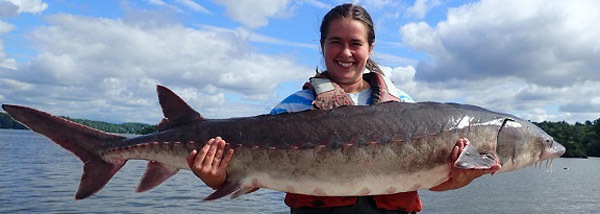 Hudson River Almanac
Hudson River Almanac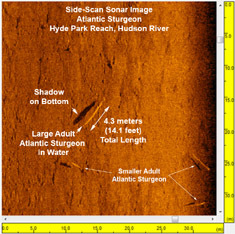 6/24 – Dutchess County, HRM 84: Using side-scan sonar, John Madsen, Department of Geological Sciences, University of Delaware, was able to map the bottom of the river across the Atlantic sturgeon spawning reach. Some of the scans produced images of sturgeon that were 10-feet-long. However, the queen of the spawning reach was a 14.1-foot-long female Atlantic sturgeon. I remember working with Michael Dadswell and Bill Dovel on sturgeon in the Hudson River a long time ago, when a sturgeon of this size seemed mythical. We heard stories from "old timers" of sturgeon 14-feet long. Of course we never believed them. (Photo of side-scan sonar image of a 14+ foot long Atlantic Sturgeon courtesy of John Madsen)
6/24 – Dutchess County, HRM 84: Using side-scan sonar, John Madsen, Department of Geological Sciences, University of Delaware, was able to map the bottom of the river across the Atlantic sturgeon spawning reach. Some of the scans produced images of sturgeon that were 10-feet-long. However, the queen of the spawning reach was a 14.1-foot-long female Atlantic sturgeon. I remember working with Michael Dadswell and Bill Dovel on sturgeon in the Hudson River a long time ago, when a sturgeon of this size seemed mythical. We heard stories from "old timers" of sturgeon 14-feet long. Of course we never believed them. (Photo of side-scan sonar image of a 14+ foot long Atlantic Sturgeon courtesy of John Madsen) 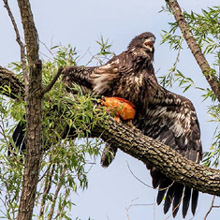 6/23 – Town of Poughkeepsie: It had been two weeks since the two baby eagles from bald eagle nest NY62 had fledged. From all accounts, they were truly “buddies.” They were flying together, perching together, and begging for food together in a manner that had not been common with previous fledglings from NY62. The adult male brought a goldfish to the nest today and, in an apparent break from camaraderie, one of the fledglings grabbed it, and then sat on it protect it. It looked like an eagle sitting on an orange football. (Photo of fledgling bald eagle with a "prized" goldfish courtesy of Bob Rightmyer)
6/23 – Town of Poughkeepsie: It had been two weeks since the two baby eagles from bald eagle nest NY62 had fledged. From all accounts, they were truly “buddies.” They were flying together, perching together, and begging for food together in a manner that had not been common with previous fledglings from NY62. The adult male brought a goldfish to the nest today and, in an apparent break from camaraderie, one of the fledglings grabbed it, and then sat on it protect it. It looked like an eagle sitting on an orange football. (Photo of fledgling bald eagle with a "prized" goldfish courtesy of Bob Rightmyer) [The northern copperhead (Agkistrodon contortrix), one of three venomous snakes in New York State, can be found in rocky, deciduous forests in the southeastern portion of the state, excluding Long Island. Adult copperheads average two to three-feet in length, although they can be larger. Its reddish-brown body has a series of hourglass-shaped bands that blend perfectly with dry leaf litter and the head is typically bright orange, hence the name. Newborn copperheads are similar in appearance to adults, although they are duller in color and have a bright yellow tail. Copperhead snakes feed on insects, frogs, lizards, and small mammals. The species is considered a “Species of Greatest Conservation Need” in New York State. Jesse Jaycox]
[The northern copperhead (Agkistrodon contortrix), one of three venomous snakes in New York State, can be found in rocky, deciduous forests in the southeastern portion of the state, excluding Long Island. Adult copperheads average two to three-feet in length, although they can be larger. Its reddish-brown body has a series of hourglass-shaped bands that blend perfectly with dry leaf litter and the head is typically bright orange, hence the name. Newborn copperheads are similar in appearance to adults, although they are duller in color and have a bright yellow tail. Copperhead snakes feed on insects, frogs, lizards, and small mammals. The species is considered a “Species of Greatest Conservation Need” in New York State. Jesse Jaycox]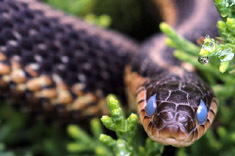 6/25 – Senasqua, HRM 36: I came across a garter snake in midday along the river at Senasqua Park. It had strange blue eyes (at first I thought I was witnessing a serpentine zombie apocalypse). But a bit of research revealed that a garter snake’s eyes may appear blue around the time it is ready to moult. The snake’s skin covers its eyes as well as its body, and the unearthly blue color is the result of the refraction of light due to an air pocket between the old and new skin layers. (Photo of garter snake courtesy of Roger Pare)
6/25 – Senasqua, HRM 36: I came across a garter snake in midday along the river at Senasqua Park. It had strange blue eyes (at first I thought I was witnessing a serpentine zombie apocalypse). But a bit of research revealed that a garter snake’s eyes may appear blue around the time it is ready to moult. The snake’s skin covers its eyes as well as its body, and the unearthly blue color is the result of the refraction of light due to an air pocket between the old and new skin layers. (Photo of garter snake courtesy of Roger Pare)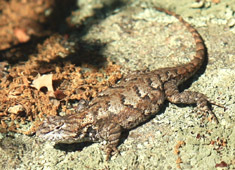 6/26 – Putnam County, HRM 56: Far above the Hudson’s waters the rocks of Breakneck Ridge were dry and warm in the bright morning sun, perfect conditions for a northern fence lizard to bask and come up to ideal operating temperature after a cool night. Including its long tail, the lizard was about seven-inches-long. (Photo of northern fence lizard courtesy of Steve Stanne)
6/26 – Putnam County, HRM 56: Far above the Hudson’s waters the rocks of Breakneck Ridge were dry and warm in the bright morning sun, perfect conditions for a northern fence lizard to bask and come up to ideal operating temperature after a cool night. Including its long tail, the lizard was about seven-inches-long. (Photo of northern fence lizard courtesy of Steve Stanne)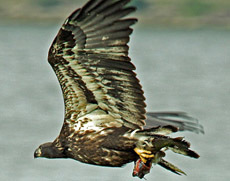 6/27 – Town of Poughkeepsie: The two fledglings from bald eagle nest NY62 had been out of the nest for about three weeks but, until now, had not shown any skills at catching their own food. Until today. This morning we spotted one of the immature eagles flying in from the river carrying a channel catfish, a prey item that has been a staple for the NY62 birds this spring. (Photo of fledgling bald eagle with a channel catfish courtesy of Dana Layton)
6/27 – Town of Poughkeepsie: The two fledglings from bald eagle nest NY62 had been out of the nest for about three weeks but, until now, had not shown any skills at catching their own food. Until today. This morning we spotted one of the immature eagles flying in from the river carrying a channel catfish, a prey item that has been a staple for the NY62 birds this spring. (Photo of fledgling bald eagle with a channel catfish courtesy of Dana Layton)